For most people, the opportunity to play a real piano is as rare as a purple unicorn. And that’s if you know your way around the instrument. If you’re only learning how to play, you may very well have to spend a small fortune to get yourself one.
Or do you? Some pundits suggest that a decent digital piano might get the job done without costing an arm and a leg. While it won’t look, sound and feel exactly like an acoustic, it’s a worthwhile alternative for the most part. The only problem is that you have to wade through countless models to get a unit that fits the bill. Why not save yourself the headache by going through this list of top digital pianos for beginners?
Contents
- 1. Alesis Recital 88 Key Beginner Digital Piano
- 2. Plixio 61-Key Digital Electric Piano Keyboard
- 3. RockJam 54 Key Portable Electronic Keyboard
- 4. RockJam RJ761 61 Key Electronic Interactive Teaching Piano Keyboard
- 5. Alesis Melody 61 MKII 61 Key Portable Keyboard
- 6. The ONE Smart Piano Keyboard with Lighted Keys
- 7. Yamaha DGX 660 Digital Piano
- 8. LAGRIMA 61-Key Electric Piano Keyboard
- 9. Yamaha Arius YDP 144 Console Digital Piano
- 10. LAGRIMA 88 Key Electric Digital Piano
- Digital Pianos Selection Tips
- Types of Digital Pianos
- Top Concert Digital Piano Brands
- Average Digital Piano Pricing
- Questions and Answers
1. Alesis Recital 88 Key Beginner Digital Piano

This has become one of the best selling home digital pianos online, and it's not that hard to see why. It comes with 88 full-sized semi-weighted keys for an organic playing experience. The keys don't quite replicate the feel of an acoustic, but they provide a more reasonable learning curve.
The unit comes with a total of of 5 voices built in: Acoustic piano, electric piano, organ, bass, and synth. These can be explored across 4 modes (Standard, Split, Layer and Lesson). The split mode lets you play 2 different voices on the right and left channels, while the layer mode combines sounds to create new ones. You also get 'Chorus' and 'Reverb' to help you make the sound flourish. The 128-note polyphony ensures every note comes out just right.
But what makes the Alesis Recital really shine is the 'Lesson' mode. It splits the unit into two 44-key sections, allowing teacher and student to play side-by-side. And if you want to practice alone, the inbuilt metronome will help you keep time while honing your rhythmic abilities. Connectivity options include the usual RCA stereo output and USB - MIDI.
Pros
-Affordable: The Alesis Recital offers lots of features for a pocket-friendly price of $200.
-Can run on batteries
-Comes with a 3-month Skoove subscription as standard. This offers access to lots of learning resources.
-Simple, elegant design: There are no confusing features cluttering up the face of the keyboard.
Cons
-Doesn't come with a sustain pedal: This must be purchased separately.
-Sound gets distorted when you go past the 60-percent volume mark.
2. Plixio 61-Key Digital Electric Piano Keyboard

Let's say you have no previous experience with the piano whatsoever. The 88-key Alesis Recital probably seems out of your league at this point, doesn't it? Why not start with the 61-key Plixio Digital Electric Piano instead?
While the lower key count translates to a relatively-smaller musical range, the Plixio does have full-size keys. In other words, it'll help you master keyboard fingering before you're ready to stretch out your arms. With 100 rhythms, 60 demo songs, 40 tones and a bunch of sound effects, the keyboard should provide a steep-but-reasonable learning curve.
The unit features a lesson mode which, while no substitute for a music teacher, can help you grasp a handful of chord combinations. It also has programming and recording functions, plus a USB port and MP3 input for customization. You also get an AUX cable and music sheet stand for the standard price of $60.
Pros
-Has a vast selection of music, with songs for a variety of interests and ages.
-The unit is light and easily portable.
-Comes with stand and mic as standard.
-Great sound for its price.
Cons
-No sensitivity adjustment on keys.
-The mains power cord wears out quickly.
3. RockJam 54 Key Portable Electronic Keyboard
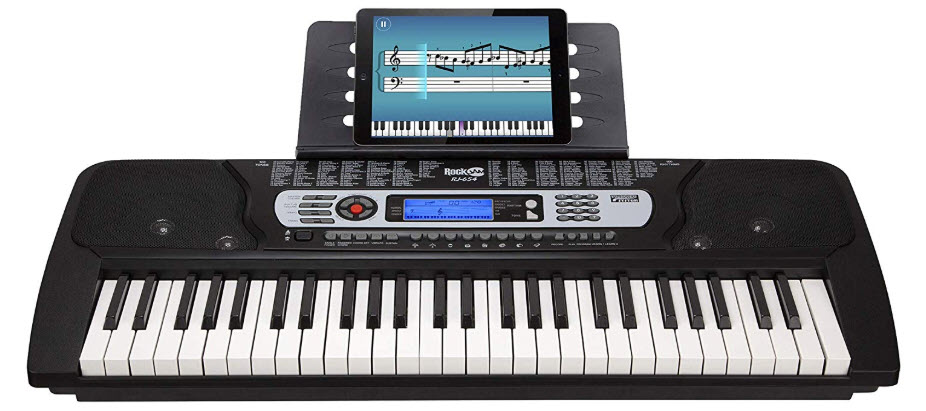
If you want to lower the key count further still, maybe you're better off with this RockJam 54-key model. The keys aren't weighted, but they provide a good feel for those who aren't yet accustomed to acoustics. The interactive teaching mode provides a low-pressure environment, thus encouraging learners to explore its full capabilities.
These include 100 rhythms, an equal number of sound effects, plus 8 demo tracks and 30 free songs. An LCD display is included to help you play along, with all relevant keys and chords highlighted. You can also customize your learning experience using the 'Piano Maestro' app.
Pros
-The blue-backlit LCD screen makes it easy to access functions and follow lessons.
-Great value for money at just $59.99
-Runs on batteries as well as mains power.
Cons
-Sound doesn't scale well along the keyboard; volume often seems low in the lower octaves compared to the upper range.
-Plugging in headphones doesn't mute the speakers.
4. RockJam RJ761 61 Key Electronic Interactive Teaching Piano Keyboard
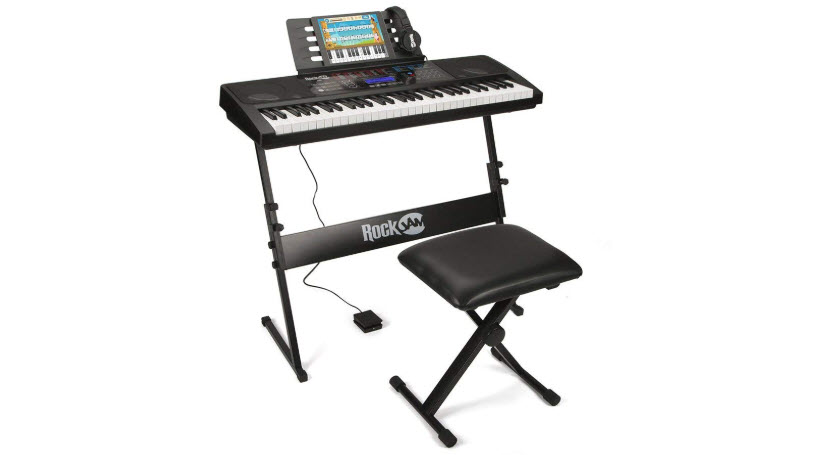
If you want the best value for money pound-for-pound, look no further than the the RockJam RJ761 SuperKit. It's a 61-key unit with an adjustable stand, sustain pedal, headphones, and a piano stool. All that for just $149.99!
Starting to look like a deal that's just too good to be true, isn't it? Well, it gets better. The keyboard comes with an LCD panel through which you can engage 200 sounds and an equal number of rhythms. For maximum flexibility, it's equipped with 3 effects (Effect, Control & Accompaniment Control).
To ensure you don't get lost amidst all the functionality, RockJam offer access to their 'Simply Piano' Application with every purchase of the RJ761-SK. You also get 30 demo songs as well as on-board practice/teaching functions. The rhythm programming function will further help when you want to create a backing to your pieces.
Pros
-Flexible: The unit can be powered using batteries when a mains source is unavailable.
-Lightweight and compact.
-Great value for money
-The LCD screen helps beginners learn quickly
Cons
-Only has 61 keys
-Unweighted keys don't provide feedback.
5. Alesis Melody 61 MKII 61 Key Portable Keyboard
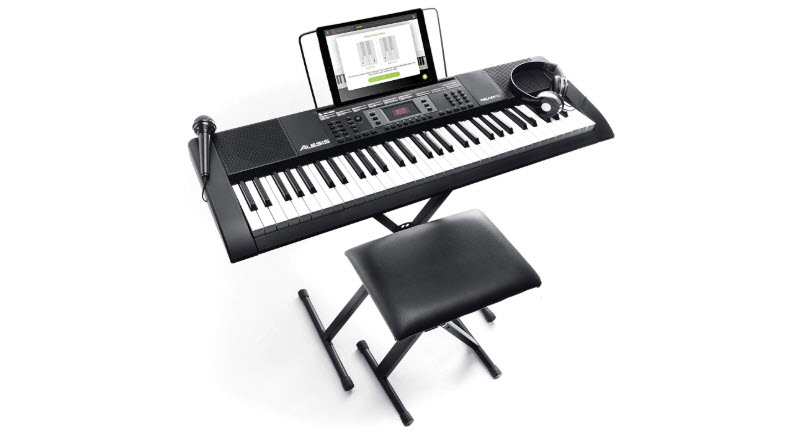
The Alesis Melody 61 MKII, like the name suggests, has 61 keys like the RockJam RJ761 above. You will however note that this is significantly cheaper; the sticker price of $99 is about two-thirds what the RJ761 costs. While less equipped on the functional side, the Alesis Melody would still make a great piano for learners.
That's because it has a vast library of 300 instrument voices plus 40 demo songs, all of which can be accessed via 3 different modes. These include the dual mode (plays 2 instruments simultaneously) and split mode (play different instruments on each side). Although keys aren't weighted, they still provide a solid-enough feel for learners who are yet to develop the right finger technique. The Alesis Melody comes with several accessories, including a microphone, headphones, adjustable stand and piano bench.
Pros
-Compact and lightweight
-Plenty of instrument sounds and demo songs to keep learners engaged
-Height-adjustable bench makes the keyboard ideal for learners of various ages.
-Offers a 3-month subscription of Skoove online piano courses as standard
Cons
-Microphone volume cannot be adjusted separately from that of the instrument.
-Lacks USB connectivity.
6. The ONE Smart Piano Keyboard with Lighted Keys
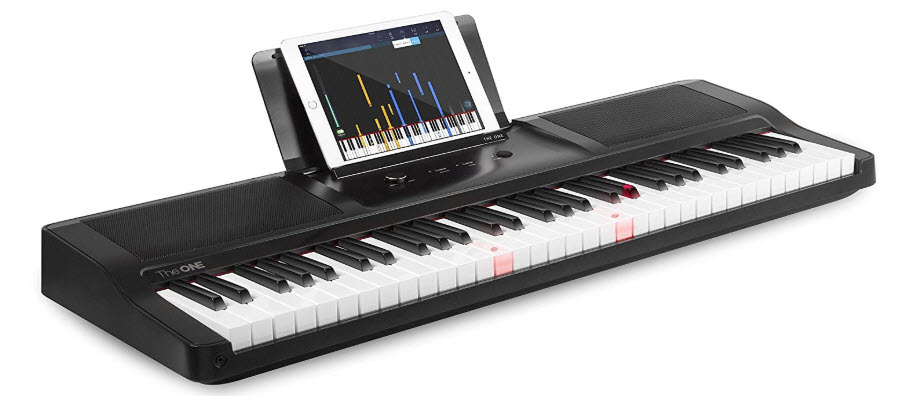
The ONE Smart Keyboard might just be the perfect model for beginners. All 61 keys are equipped with LED lights; these blink to show you which note to play next. If that isn't enough, how about an interactive app with tutorials and games?
The unit doesn't do much to hide its tech-heavy operation. The main panel has a plethora of knobs and buttons: these vary from the usual volume control to the Sustain and Tone Setting buttons. The latter lets you select from 20 in-built tones. Sound is delivered via a 128-note polyphonic chip through the 2 speakers.
Pros
-Lightweight: At just 11 pounds, the ONE Smart Piano can be carried around with ease, both from one room to the next and on the road.
-Backlit keys help musicians work the keyboard with ease.
-Wide variety of song selections.
Cons
-The $219 price tag might be too hefty for some, especially considering that this is a 61-key unit.
7. Yamaha DGX 660 Digital Piano
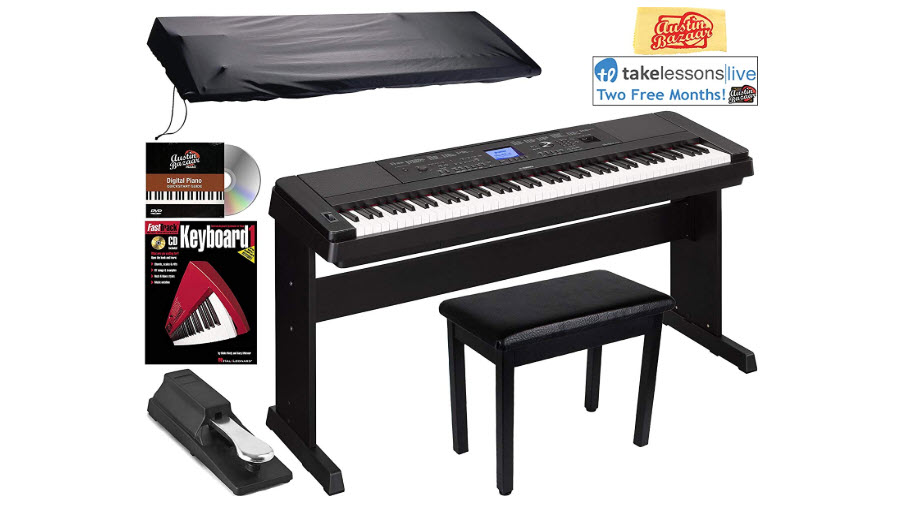
At 55" wide and 5.7" high, the Yamaha DGX-660 appears standard-sized for an 88-key digital piano. So why then does it weigh a massive 46.3 lbs? That's without the stand, mind you. With it, the DGX-660 obliterates the scales at 62 pounds.
There is, of course, a good reason for the heft; Yamaha's proprietary Graded Hammer Standard. This mechanism uses graded hammers to simulate the tactile response of a traditional acoustic. The action feels heavier on the lower register and gets lighter as you travel up. To help make the most of the weighted action, the unit has a touch sensitivity control feature with 4 settings (Hard, Medium, Soft and Fixed).
The Pure CF sound engine has 10 different piano sounds and 151 voices in total. You can also take advantage of 15 drum/sfx kits for added depth. To top it all off, the unit is equipped with a 'Pitch Bend' wheel. Usually reserved for synthesizers, this feature alters the pitch of a note to create interesting effects.
The DGX-660 has plenty of other features, but learners will be more interested in Yamaha's Educational Suite. This is a series of lessons covering everything from notes to chord recognition and harmony. Another notable feature is the 'Piano Room' --- this applies optimum settings for piano performance at the touch of a button.
The Yamaha DGX-660 retails at $850. For that, you get the keyboard plus a few accessories, including a stand and foot switch.
Pros:
-Action-weighted keys.
-Generous library of songs, voices and sound effects.
-Has 2 pairs of speakers (12 cm and 5 cm), plus two 6W amps for a rich, balanced sound.
-Plenty of connectivity options, including USB-to-Host, AUX in, headphone jack, as well as a mic jack with a dedicated volume control.
Cons
-Too bulky to be anything close to portable.
-Price isn't very beginner-friendly.
8. LAGRIMA 61-Key Electric Piano Keyboard
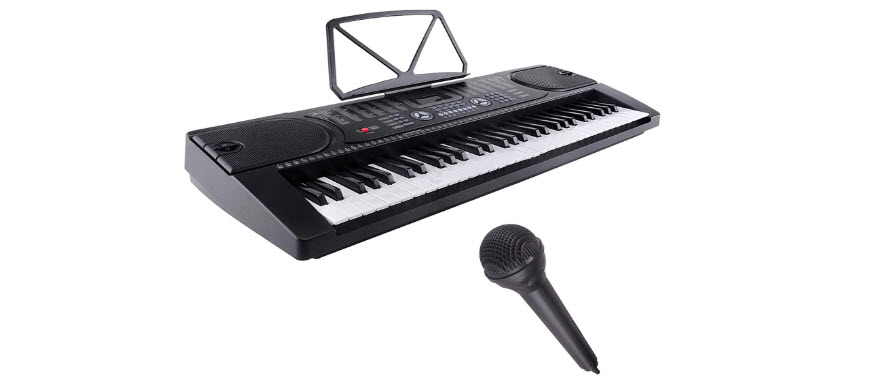
Completing a trio of sub-$100 keyboards on the list is this $54, 61-Key unit from LAGRIMA. While they're not as famous as, say, Yamaha, LAGRIMA have still done a wonderful job here. The keyboard seems to have this premium allure to it, mostly thanks to the silver color scheme and curvy contours.
A skeptical eye will know better than to judge by looks, of course. But it's hard not to see the essence of a user-friendly charm on a beginner piano. Designated a 'Starter Practice Keyboard Piano', the LAGRIMA Portable Keyboard is tailored for learners ranging from pre-adolescent to adults.
The 33.8- by 12.7-inch housing provides ample space for the 61 keys. These have a smooth texture and soft tact to help beginners master the sensory connection. The functional side is equally impressive: the piano has a 200-timbre capacity, 128 rhythms and 12 demo songs. A small LCD screen lets you access the various functions, including record & playback, sync/fill-in, rhythm programming, and much more.
Pros
-Can run on 6 AA batteries or mains power
-Low-priced
-Has a Dual Mode for lessons
-Simple programming
Cons
-Sound quality is less-than-satisfactory, even at this price point.
9. Yamaha Arius YDP 144 Console Digital Piano
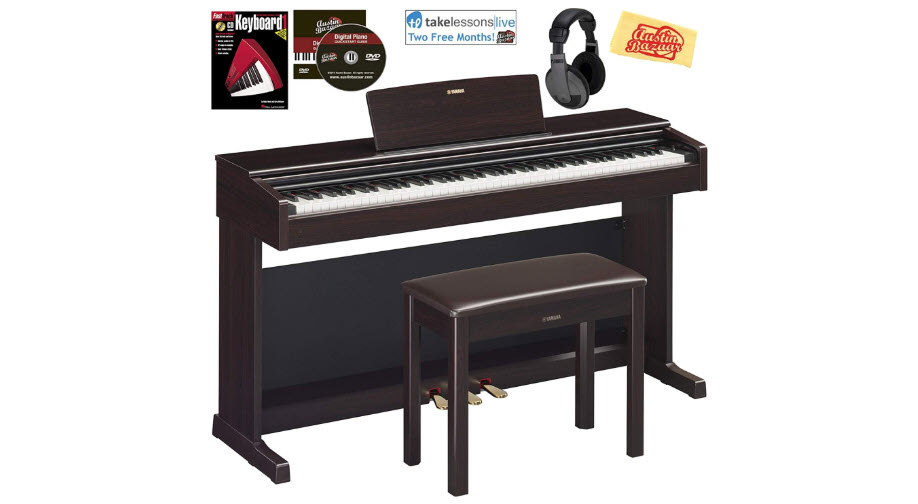
Yamaha's venerable YDP-143 console digital piano has been on the market for 3 years now. That's long enough to deserve an upgrade, and the manufacturer has dutifully obliged with the release of the Arius YDP-144. Retaining the console style, this model seeks to take on from where its predecessor left off.
Don't expect too many novelties though -- the minimalist setup from the YDP-143 remains unchanged. Besides the usual 88-key keyboard, controls are limited to a volume knob on the left side, plus a few buttons on the other end. Yamaha also seem convinced that even with a $1,099 price tag, the YDP-144 doesn't need a screen. The keys feature the same GHS action discussed earlier, with 4 touch-sensitivity options.
The only notable change is the sound; the YDP-144 features the CFX engine found on Yamaha's more advanced models. You get a total of 10 sounds and 3 effects. The 192-note polyphony ensures notes won't cut out as you play. The unit also features 2 modes (Layer and Duo), and a 2-track MIDI recorder.
Pros
-Elegant design and stellar build quality
-Superb sound quality thanks to the CFX engine.
-Compact size for a console model
Cons
-Terrible control setup: Without the 'Smart Pianist' app, you're forced to rely on some difficult-to-remember key combinations.
10. LAGRIMA 88 Key Electric Digital Piano
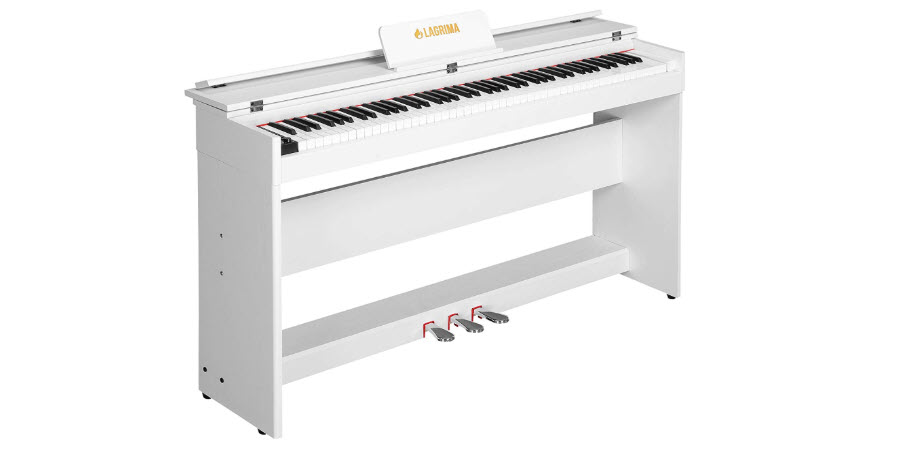
Yet another good-looking bundle from LAGRIMA. Unlike the 61-Key model highlighted earlier, this is designed for those who want to master the finger technique of a traditional acoustic. All 88 keys are equipped with graded hammer weights for that purpose.
There's also a touch sensitivity feature that adjusts key volume to match the players intensity. This can however be turned off. Elsewhere, the unit has a built-in pedal board and sheet music stand to provide the experience of playing an acoustic.
The DSP2000 sound sample gives the piano more stable, clearer sound than you'd expect for its $315 price tag. You also get 480 tones and 200 preset rhythms, plus a total of 80 demo songs. The 64-note polyphony enables highly expressive playing, though not as much as other units in the price range.
Pros
-Has a dual mode for a richer learning experience.
-Touch sensitivity can be turned on/off for better control
-Great sound quality, thanks to the under-cabinet speaker setup.
Cons
-Build quality leaves a lot to be desired.
-Assembly instructions aren't as clear as they should be.
Digital Pianos Selection Tips
If you are a piano lover but your home does not have enough space to accommodate the canonical measurements of the traditional pianos, there is no need to give up. Digital pianos are smaller than classic models and are easy to carry.
The digital unit is an instrument that is popular thanks to its size, low maintenance requirements and the excellent sound quality it produces. Unlike the traditional options, it does not need tuning and is equipped with a MIDI output that allows connection to the computer and other electronic instruments.

It is a good solution for those who use the instrument with headphones. Depending on the model, you can choose a keyboard with plastic buttons or a more refined one with wooden buttons.
Oftentimes, people who try a piano for the first time find themselves faced with a difficult choice. The market is overflowing with options and it is not always easy to make the right choice.
For example, a piano might have a great volume, good sound but it may still not provide the right choice for you. The pianos are made to last. For this reason, it is necessary to consider the available options carefully.
This allows you to choose the best digital piano for your needs and you will not find yourself having to regret the wrong choice. It is helpful to follow some key steps that can help you pick the most suitable model.
One of the key considerations is skill level: a beginner will have different needs when compared to an experienced user. As a beginner, you can choose a cheaper model with a smaller range of features without necessarily having to compromise on sound quality. Once you become more experienced, you can buy a more advanced instrument.
Another aspect that must be taken into account is the price: the market for musical instruments is extensive. The best way forward is to consider how much you really want to spend. Keep a realistic figure in mind for your needs. Saving money at any cost is not always a good idea, especially if savings are made at the expense of sound quality.
One of the reasons many people opt for digital pianos is the size. These models are generally more compact when compared to traditional models. They are designed in a way that maximizes portability.
If you are not going to carry the piano around, you can opt for one of the larger models. However, always pay attention to the space you have at home. As with any bulky piece of furniture, the best approach is to measure the space beforehand.
Instruments with light keys are less expensive; hence, they are the first choice of many new pianists or keyboard players. Unfortunately, going forward it will be increasingly difficult to play the piano, for example, in class with the teacher and the exercises performed at home on the keyboard become a waste of time.
In addition, the time will come when you have to buy a digital model or an instrument with the weighted keys. As such, the previous purchase is likely to collect dust in the cabinet, especially if it is not in great demand and, therefore, difficult to resell.
You can also consider the extra features you want. Depending on your needs, you may need USB connectivity, an amplifier connector or a headphone jack. Some digital models have dedicated software that allows not only to record music but also to translate it in real-time into a score. Choose features you cannot do without and go for a model that ticks the right boxes.
Types of Digital Pianos
When selecting a digital piano for beginners, you can find two main variants from which to choose. These include portable and grand digital pianos. The former is favored by most novices for a number of reasons, such as portability, affordability and the compact size, which eliminates the need for large storage spaces.
Top Concert Digital Piano Brands
A number of leading piano brands offer high-quality instruments worth considering when selecting a digital piano for beginners. These brands include Yamaha, Casio, Kawai and Roland.
Yamaha
Yamaha sells digital units that offer high-quality dynamic sound and guarantee a natural response to touch. Clavinova is a good example of Yamaha’s impressive collection. The model is a real grand piano with a digital heart. This instrument makes it easier to raise the standards to levels never seen before.
On the other hand, Arius is a series of advanced and sophisticated pianos that provide the feeling of sitting in front of a traditional instrument having access to the features of a modern console. Meanwhile, Modus showcases modernity thanks to the innovative contemporary and elegant design, which goes beyond the common approaches. The price of Yamaha pianos ranges from $400 to around $2,600.
Casio
Casio, a Tokyo-based company produces high-performance instruments with multiple features. They are ideal for those looking for a musical instrument with a sound range without borders. People who work in music or are simply passionate about it know the potential of the products made by Casio and the continuous development of innovative designs.
Privia, Celviano and Compact series are Casio’s top offerings for the production of digital music. These are pianos and keyboards come with a classic but contemporary design. They are capable of satisfying the needs of novice pianists and expert composers looking for the best for their performance.
Roland
This Japanese company founded in Osaka in the early 1970s produces quality digital variants suitable for all types of users. The sound produced is absolutely clear and pleasant.
The company has been committed to digital evolution for years, creating products with increasingly advanced features. The V-Piano and V-Piano Evolution series presents five types of products in total capable of revolutionizing the way music is defined.
Roland did meticulous work on the synthesis that led to a more than excellent sound quality. Whether you a beginner or expert musician, Roland has the right solution for you.
Kawai
Thanks to the great experience, the Kawai brand produces high-quality pianos that are close to the sound of acoustic variants. As a leader in the production of tail instruments, Kawai has been specializing in this section of the market.
Made in collaboration with the best pianists in the world, Kawai digital pianos perfectly achieve the qualities of a traditional instrument, thanks to the transposition of craft techniques onto digital production.
Average Digital Piano Pricing
The prices of a digital piano vary greatly depending on the brand and type of product. Entry-level instruments that have plastic keyboards are cheaper when compared to high-performance units with wooden keyboards.
Before choosing, you need to identify your specific skills, needs and objectives. It is not advisable to buy an expensive model equipped with many functions if the applications will be oriented towards learning the basics.
Conversely, if you are a professional, it is advisable to invest in a high-end model, which offers advanced features and superior sound quality. The price variable of a digital piano is also based on the mechanics and quality of the materials used.
Experts will opt for models with a keyboard that has good transmission mechanics, which simulates the weight difference of the hammers. In simpler terms, it is necessary for the keys to offer a touch similar to that of an acoustic piano.
You can also find more expensive models equipped with a collection of samples taken from acoustic pianos. This allows you to reproduce all the notes and expand the radius of creation of the musician. If you are an expert, polyphony is an important element to evaluate in the purchase.
It allows you to work on a wide range of notes at the same time, so a piano with 64 polyphony notes will be more suitable than one with 32. You can also find high-performance units with up to 256 polyphony notes, which reproduce the sound of the traditional piano with precision.
If you are a beginner, the fundamental requirement is that the keyboard is weighed and has 88 keys otherwise it becomes difficult to learn. Obviously, when selecting a digital piano for beginners, make sure that the sound is satisfactory for you. The beginner’s exercise is not only technical but also auditory.
Questions and Answers
Which digital piano brand is best?
To get right to the point, here’s a list of 5 brands (according to our estimate) that excel in the manufacturing of digital pianos (DPs). These are:
• Yamaha
• Roland
• Kawai
• Casio
• Korg
There are many different types and styles in DPs that also incorporate a variety of different manufacturing details. And then there is the price of the instrument to consider. All the above-mentioned brands offer a good variety of different models and across varied price points as well.
Having said that, there are a number of subtle aspects that set apart models from one brand to that of another. For example, models from a particular brand may give you exceptional voices and tones but may not necessarily excel when it comes to factors such as weighted action or escapement. We can’t go into a detailed discussion of these factors right here, but do keep this in mind when choosing any model from a particular brand. This is especially relevant for intermediate level pianists—or practically for anybody who takes his piano playing seriously.
How much does a digital piano cost?
If you want to possess a piano of your own, of course a DP is the less expensive option and you can get a decent instrument in the $600-$1,000 range. It also depends on the type of digital piano you are opting for. Digital grand pianos, for example, will cost more than the upright pianos. And, if you are a professional, you may like to go for a digital stage piano. The price will normally depend on the make, materials and the features of a particular model and the very bests in the line may cost you up to thousands of dollars. So, make sure you do your homework and choose an instrument that best suits your present requirements.
Do digital pianos sound like real pianos?
Any decent acoustic (or real) piano comprises of 6,000 — 9,000 moving parts; they use wooden soundboards, a wooden case or cabinet, metal strings, hammers, a cast iron frame…and so on. So, naturally, you cannot expect the same quality of sound from a DP (the sound of which is, after all, a digital file) as from an acoustic piano. That said, a digital piano (apart from its other benefits—less expensive, space-saving, etc.), especially a digital piano of today, thanks to advancement in relevant technologies, is able to mimic acoustic piano sound in more than a decent manner. And especially, if you are investing in a high-end instrument (and you’re not too fussy a la a piano virtuoso!), you’ll have little to complain about the sound.
Do digital pianos have to be tuned?
Normally, you don’t need to tune your digital pianos since they don’t go out of tune like acoustic pianos. However, it may sometime happen that one or two notes may bother you (not the right pitch, etc.). In such cases, you may edit those notes if your instrument permits this or you may try for a factory reset.
Do digital pianos have pedals?
Commonly, most digital pianos will have at least one pedal plugged-in to the instrument and this is the volume pedal. However, more important than the volume pedal (which you can plug in externally as well) is the sustain pedal (also called a half-damper). This pedal is essential to piano learning. So, even if you are buying your digital piano for a beginner, you must see to it that the model includes a half-damper.
What do the 3 pedals on a piano do?
The three pedals found in most acoustic and traditional pianos are the sustain pedal, the soft pedal and the sostenuto pedal. The last is required by the accomplished pianists only. Although rare, there are still a few digital piano models that include all these three pedals.
